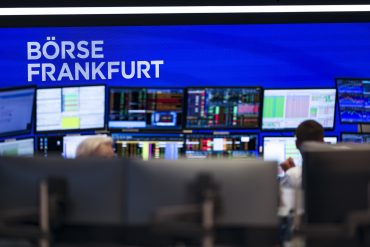
- AI Investment
- Earnings Season
- Global Markets
European Markets Open Lower Ahead of Major Earnings Reports
6 minute read

Europe’s Q3 earnings season tests resilience as €200 billion in AI investment reshapes strategy and energy volatility pressures margins across sectors.
Key Takeaways
-
€200 billion AI transformation: The EU’s InvestAI program mobilizes public capital for data infrastructure and sovereign computing, lifting total AI investment beyond €30 billion this year.
-
Energy volatility risk: Sanctions on Russian producers raised Brent to $67.60 per barrel, tightening margins for refiners and exporters and complicating ECB policy.
-
Cross-sector resilience test: Reports from Roche, Unilever, Nokia, Lloyds Banking Group, and Kering will gauge Europe’s ability to balance innovation funding with cost discipline under shifting trade and fiscal conditions.
Introduction
The choreography of quarterly disclosures rarely reveals its full significance in a single day’s releases. Yet as Europe’s leading corporations prepare to report third-quarter results on October 23, 2025, the cadence of market expectations has shifted from ritual anticipation to something more searching—a diagnostic of how deeply structural forces now penetrate operational performance.
Roche Holding, Unilever, Nokia, Lloyds Banking Group, and Kering headline an earnings slate whose breadth cuts across pharmaceuticals, consumer staples, telecommunications, financial services, and luxury goods. The diversity itself is instructive. In previous cycles, such cross-sectoral reporting might have yielded discrete narratives: healthcare innovation proceeding on its own timeline, consumer sentiment registering transient shocks, banking adjusting to rate environments. This quarter, however, convergent pressures—technological transformation, geopolitical friction, and monetary recalibration—render boundaries between sectors increasingly porous.
Consider the macro backdrop. The European Central Bank’s calibrated easing continues against persistent inflationary echoes, while transatlantic policy under a second Trump administration introduces fresh uncertainties around trade architecture and sanction regimes. EURO STOXX 50 futures reflect this ambiguity, trading near equilibrium on Eurex as investors await not merely earnings beats or misses, but evidence of adaptive capacity. The question is no longer whether corporations can navigate this environment, but whether they are fundamentally reconfiguring operations to thrive within it.
The AI Investment Inflection
Beneath these quarterly rhythms, a more consequential shift proceeds with less fanfare. European venture capital flows into artificial intelligence and adjacent deep technologies have stabilized at approximately €15 billion annually—a figure that represents not retrenchment from 2021 peaks but maturation. This is nearly 50% above pre-pandemic baselines, and the composition of investment has grown markedly more sophisticated. The appetite for speculative consumer applications has given way to focus on scalable models with defensible competitive positions: AI-driven diagnostics, quantum-secure network infrastructure, supply-chain optimization platforms.
The European Commission’s InvestAI initiative, launched in February by President Ursula von der Leyen, has accelerated this trajectory substantially. The program mobilizes €200 billion in capital to construct computational sovereignty, including €20 billion allocated for up to five “gigafactories” dedicated to AI infrastructure. By year’s end, total AI investment across the European Union is projected to exceed €30 billion—nearly double 2019 levels.
These figures transcend mere fiscal stimulus. InvestAI represents a strategic wager that Europe’s regulatory framework—notably the AI Act and Digital Services Act—can be repositioned from perceived competitive liability to genuine advantage. The transparency mandates and risk-tiering requirements these regulations impose carry real compliance costs, particularly for smaller innovators lacking deep legal resources. Yet they also cultivate trust as a commodity, potentially attracting ethical capital and risk-averse enterprise clients who view regulatory clarity as preferable to jurisdictional uncertainty.
The market implications are already visible. Public capital is de-risking private investment decisions, fostering ecosystems where “AI-native” enterprises—those embedding intelligence into core operations rather than treating it as peripheral enhancement—command valuation premiums. Unilever’s supply-chain optimizations and Roche’s therapeutic pipeline developments exemplify this integration. For venture architects, the landscape increasingly favors incumbents with resources to navigate compliance labyrinths, a dynamic that paradoxically concentrates innovation even as policy aims to democratize it.

Energy Markets and Geopolitics
Parallel to these technological currents, energy markets have experienced renewed volatility following U.S. Treasury designations of Rosneft and Lukoil under Executive Order 14024. The sanctions, targeting Russian energy entities for their role in the Ukraine conflict, triggered a 3% spike in Brent crude before futures moderated to $67.60 per barrel by October 22—below the $70 intrayear norm but sufficient to layer fresh risk premia onto European import costs.
The sanctions embody the Trump administration’s return to economic statecraft as primary instrument, wielding restrictions simultaneously as scalpel and sledge. Moscow’s tentative de-escalation signals suggest the strategy retains coercive power, yet the collateral impact on European refiners and manufacturers remains substantial. For the ECB, energy price volatility complicates an already delicate inflation remit, potentially prolonging restrictive monetary postures even as growth indicators soften.
Continental corporations with sophisticated hedging operations, including refiners maintaining robust throughput amid commodity swings, may weather this volatility. Others with less flexible cost structures face margin compression. The divergence in corporate responses will likely emerge in today’s disclosures, particularly among industrial and transportation-dependent sectors.
Sectoral Crosscurrents
The banking sector’s quarterly results arrive amid accelerating pressure from fintech insurgents. Lloyds faces the challenge of neobanks whose customer-centric architectures fundamentally challenge legacy deposit moats and lending algorithms. The competitive dynamic extends beyond digital interfaces to algorithmic credit assessment and personalized financial products—areas where AI integration becomes not optional enhancement but existential requirement.
Nokia’s 5G disclosures similarly spotlight telecommunications’ precarious position at the intersection of technological advancement and regulatory fragmentation. Spectrum auctions remain zero-sum contests where AI-orchestrated network management promises efficiency gains, yet regulatory harmonization across member states lags. The AI Act’s mandates for audits of high-stakes AI deployments introduce additional complexity, forcing telecommunications providers to balance innovation velocity against compliance overhead.
In luxury goods, Kering’s results offer insight into consumption patterns among affluent cohorts increasingly exposed to wealth effect volatility from both equity and property markets. The sector’s resilience through previous cycles suggests some insulation from broader economic headwinds, yet softening consumer pulses—even at premium tiers—would signal deeper structural concerns.
The American Parallel
Across the Atlantic, corporate disclosures reveal comparable tensions. Tesla’s third-quarter revenue rose 12% to $28.1 billion, yet operating margins compressed to 5.8%—a 501 basis-point erosion year-over-year—while GAAP earnings per share fell 37% to $0.39. Energy storage revenue growth of 44% could not offset automotive softness, illustrating scaling challenges amid subsidy flux. The reflexive 3% share price decline underscores investor sensitivity to execution risk even within growth narratives.
These American results provide useful context for European corporations navigating similar dynamics: strong topline growth masking margin pressure, innovation in emerging segments insufficient to compensate for legacy business maturation, and heightened scrutiny of capital allocation efficiency.
Strategic Implications
Today’s earnings cascade thus represents less a discrete reporting event than a window into structural adaptation. The €200 billion AI investment surge creates opportunities in resilient niches—pharmaceutical informatics, green logistics, algorithmic financial services—while sanction-fueled energy volatility exacts tolls on legacy exposures.
For policymakers, the imperative remains bridging the transatlantic venture capital gap without allowing regulatory rigor to calcify into competitive drag. For investors, the opportunity lies in discerning which corporations are genuinely embedding intelligence into operations versus those deploying AI rhetoric as defensive positioning.
As European indices trade near equilibrium this morning, the underlying currents run deeper than price discovery alone. What emerges from this earnings season will shape not quarterly portfolio adjustments but multi-year strategic allocations—the difference between capital seeking shelter and capital financing transformation.







